Lawn Turf Installation in Pinner: Transform Your Outdoor Space

Are you dreaming of a lush, green lawn in your Pinner home? Lawn turf installation is the perfect solution to achieve a beautiful and healthy yard. Whether you’re looking to renovate your garden or establish a new lawn, professional turf installation can make a significant difference.
Installing lawn turf involves several steps, from selecting the right type of grass to preparing the soil properly. With the right approach, you can enjoy a vibrant lawn that enhances the beauty and value of your property.
In Pinner, there are many factors to consider when choosing the perfect turf for your garden. This article will guide you through the process, ensuring you make informed decisions every step of the way.
Why Choose Lawn Turf Installation?

Lawn turf installation is a quick and efficient way to establish a green space in your garden. Unlike planting grass seed, which can take time to grow, turf provides an instant lawn. This immediate transformation can be particularly beneficial for those who want to improve their garden's appearance quickly.
Moreover, professionally installed turf ensures that your lawn is even, dense, and free of weeds. This attention to detail helps prevent common lawn problems, such as patchiness and invasive species growth.
Another advantage of turf installation is the variety of grass types available. From soft, fine-bladed grasses to hardy, drought-resistant varieties, you can choose the perfect turf to match your garden’s needs and your personal preferences.
Benefits of Professional Turf Installation

- Time-Saving: Professional installers can lay turf quickly and efficiently.
- Expertise: Experienced installers ensure proper soil preparation and installation techniques.
- Quality Assurance: Professionals use high-quality turf varieties suited to your climate and soil conditions.
- Long-Term Savings: A well-installed lawn requires less maintenance and is less prone to issues.
Investing in professional lawn turf installation in Pinner means you’re choosing quality and reliability, ensuring your lawn remains healthy and vibrant for years.
Choosing the Right Turf for Your Pinner Garden

Selecting the right type of turf is crucial for the success of your lawn. Factors such as climate, soil type, and the intended use of your garden play a significant role in determining the best turf variety.
In Pinner, the climate is generally mild, making it suitable for a wide range of grass types. However, considering the local weather patterns, choosing a grass that can withstand occasional droughts and heavy rainfalls is essential.
Some popular turf options include:
- Fescue: Known for its fine texture and rich green color.
- Ryegrass: Offers quick germination and is excellent for high-traffic areas.
- Kentucky Bluegrass: Renowned for its durability and lush appearance.
- Bermuda Grass: Ideal for sunny areas and drought resistance.
Soil Preparation for Turf Installation

Proper soil preparation is the foundation of a healthy lawn. It involves clearing the area of debris, weeds, and old grass, followed by tilling the soil to create a smooth, even surface.
In Pinner, where the soil may vary, testing the soil’s pH and nutrient levels is advisable. Adjusting the soil to the appropriate pH and adding necessary fertilizers can promote better turf growth.
Compaction can be an issue in some areas, so ensuring good drainage and soil aeration will prevent waterlogging and root diseases, ensuring your turf thrives.
Step-by-Step Lawn Turf Installation Process

1. Planning and Measurement
Begin by measuring the area where you want to install the turf. Accurate measurements ensure you purchase the right amount of turf and avoid wastage.
2. Clearing the Area
Remove any existing vegetation, rocks, and debris. This step is crucial for preventing weeds from growing through your new lawn.
3. Soil Preparation
As mentioned earlier, prepare the soil by tilling, adjusting pH levels, and adding fertilizers. Creating a well-drained base is essential for healthy grass roots.
4. Laying the Turf
Start laying the turf from one corner, ensuring each roll is tightly butted against the next to avoid gaps. Stagger the joints like bricks for a more natural look and better stability.
5. Watering and Care
After installation, water the turf thoroughly to help the roots establish. Maintain consistent moisture during the initial weeks to promote strong growth.
6. Ongoing Maintenance
Regular mowing, fertilizing, and occasional watering will keep your lawn looking pristine. Address any weed issues promptly to maintain the health and appearance of your turf.